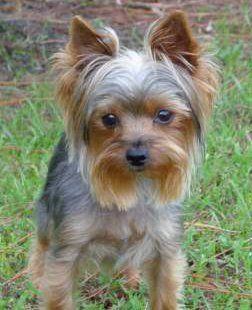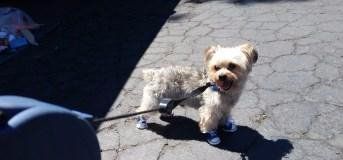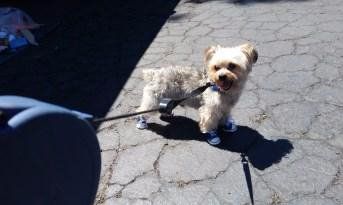Yorkie Training Tips
Pokey, 18 month old medical alert dog
Photo courtesy of Lizette Mierisch
The 10 Most Important Tips for Housebreaking & Command Training
Please note: YorkieInfoCenter is reader-supported, and some of the product suggestions on this page are affiliate links. As an Amazon Associate we earn from qualifying purchases. This is at no extra cost to you and helps us continue providing free, high-quality information.
# 1- Training goals should be age appropriate.
Certainly owners should plan to train their Yorkie for housebreaking, commands and socialization...and to a key to success is to have appropriate expectations.
Puppies can begin training at 8-weeks-old. In regard to housebreaking, it is important to understand that bladder and bowel muscles need to develop and strengthen as the pup grows.
During the weeks (and first couple of months) that a pup is being shown what to do and where to go, these lessons will start to be instilled while muscles are developing...And the end result by the age of 3 to 4 months, is a well trained dog.
# 2 - Age in Months = Hours Needs can be Held
The best way to estimate how long you can expect a puppy to hold his needs is to remember that a 2 month old can hold on for only about 2 hours, a 3-month-old no more than 3 hours and so on.
This continues until the Yorkie can hold on for about 8 hours. Expecting more than this length of time is unrealistic.
# 3 - Choose One Area
Simply just choosing "outside" as the bathroom area is not going to teach solid lessons. Owners should choose one specific location that will only be used for housebreaking. Please keep in mind that an area chosen in the spring may not work well in the winter. Think about how things will work when it is raining, snowing and/or the weather turns cold.
No other activity should take place in that spot...It should not be an area that your dog plays near and it should not be near a BBQ, patio deck, etc.
#4 The 15 Minute Rule
Just about 15 minutes after eating a meal, a Yorkie puppy
should be taken to the designated area, and owners should allow the puppy to have at least 15 minutes to pee or poo.
One of the most common mistakes that owners can make is to expect their puppy to go to the bathroom within just minutes of being brought outside. Certainly, if the puppy has an immediate need, this may happen.
However, it is more realistic to allow time for the pup to choose the perfect spot within the chosen area...and for bladder and bowel muscles to relax enough to release urine and/or bowel movements.
While standing outside, time can seem to creep by very slowly. So, a good tip is to keep yourself occupied while your Yorkie sniffs around. Read a book, messages on your phone, sit on an outdoor bench if you must, but remain in the area for at least those 15 minutes.
One of the biggest frustrations of owners trying to train their puppy is that the pup goes to the bathroom as soon as he is brought back into the house...And this is often the result of not allowing for enough time.
# 5- If He Has to Go, He Has to Go
Crates and other confinement methods will not stop a Yorkie puppy from urinating or having a bowel movement if the body simply cannot hold it in.
While canines dislike soiling in an enclosed area, expectations must be realistic. When young, usually up until the age of 4 months, puppies will wake up at least one time per night and should be taken outside (or to pee pads). Note - Allowing a Yorkie to use pee pads placed in a crate at night will be counterproductive to trying to train the pup to using them placed elsewhere during the day. So better is to bring your Yorkie to the designated area and allow him or her to go to the bathroom.
If your Yorkie must be home alone during the day, using a canine play pen
or gating off an area will work better than crating. Close confinement while awake only puts stress on a dog, which leads to destructive behavior, barking and mis-behavior when released.
# 6 - Be Aware of the Signs
The next tip sounds simple enough: Watch your dog for signs that he or she is about to go to the bathroom, however owners must be right on top of this. Within seconds of lifting a leg or squatting, it may be too late to bring the pup outside. By tethering a puppy to you, you can keep an eye on the pup, noticing signs such as pacing around, appearing to be restless, whining, etc. Each dog is different and each will have a "tell", which is a physical or verbal cue that bathroom needs are eminent. As soon as you see this, bring your Yorkie out, even if this means carrying him and jogging to the designated area for the pup to finish what may have been started inside.
#7 - Scheduled Times
When training, have set scheduled times that you bring your puppy outside. These include: Firs thing in the morning, immediately after waking up from any naps, 15 minutes after eating, right before bedtime...and as mentioned above, any time you think you see a sign of this need.
# 8 - Don't Run for Nighttime Cries
Puppies may whine and cry at night. If you have already brought your Yorkie out for bathroom needs and if he or she is safe and comfortable, with appropriate supplies, it is best to not respond. This attention seeking behavior can be the foundation that creates an endless circle of this behavior.
Respond one time, allowing your Yorkie an opportunity to have a drink, then bring him outside while keeping lights low, not playing and keeping talking to a minimum.
After the pup urinates or eliminates, return the puppy to his sleeping area. Be sure that the area is warm, soft (baby blanket) and there is a favorite toy. Then, do not respond to barking or whining that takes place afterward. This allows a Yorkie to learn self soothing methods, which are needed to cope at other times, such as when home alone during the day.
# 9 Rewards, Not Reprimanding
Offering praise and treat for desired behavior works 1000 times better than acting upset about undesired actions. Dogs will not learn a thing from an owner being upset, yelling, sighing or muttering under their breath. However, a Yorkshire Terrier will learn and will remember lessons when given praise and made to feel that his owner (the "leader of the pack") is proud of his actions and behavior.
# 10 - Small Steps
In regard to training, both for commands and for house training, celebrate the small successes along the way. This keeps both dog and owner motivated to continue on and improve. One of the most important tips is that a dog will mimic his owner in regard to enthusiasm. An owner must act as a coach, cheering their pup to take appropriate actions, giving out great praise when done correctly and having a "that's okay, let's try again" attitude if mistakes are made.
Bonus Tip: You know, we really
wanted to stick with 10 pointers, because well...that's a nice even number. However a very important rule is to teach your Yorkie that it is you who is in charge. We all want to spoil our pets and that 's perfectly fine. But at the same time, behavior can tend to be a bit out of control and a dog will tend to not listen
to owners unless he respect them. Show your Yorkie that you are the leader by only placing down his dinner dish after he obeys the 'sit' command and by always being the first to enter and exit the house.
Up Ahead:
Aggression
- What to do and how to react if your Yorkie is being very aggressive to you or other members of the household.
Chewing - Covers both teething and adult chewing issues.
You may also like:
Yorkshire Terrier Socialization Training
- The things that a Yorkie should be socialized to and exact methods to do it.
More Information
Oh, the silly, odd & curious Yorkie behavior that our best friends can bring to us! Read about the 24 different Yorkie behaviors, with detailed training for each...see what we have for you inside of the YorkieInfoCenter Book.



